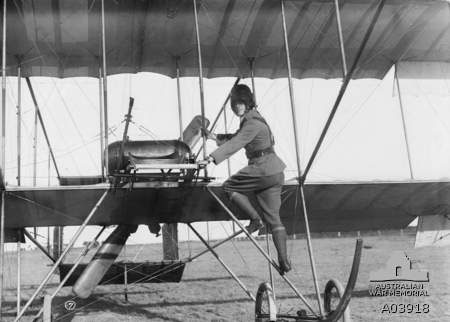George Pinnock Merz was born at Prahran on 10 October 1891. A graduate (1914) in Medicine at the University of Melbourne, he was commissioned (1913) second lieutenant in the Melbourne University Rifles and was one of three Militia officers of the first four officers (including the future Air Marshal Richard Williams) to be selected for the first military flying course conducted in Australia from 17 August-28 November 1914.
Merz was dux of this three months course conducted at Point Cook and the second officer to gain wings in military flying in Australia. He was selected as one of two pilots despatched as the aviation component of the Australian Naval and Military Expeditionary Force to Papua New Guinea over the period 27 November 1914 to 22 January 1915. He returned to Australia and in March 1915 is shown in a photograph of the First Half Flight of the Australian Flying Corps in camp at Point Cook. Merz was appointed as an instructor on the second flying course, an appointment he held concurrently with his work at Melbourne Hospital.
On 23 February 1915 Senator G F Pearce, the Minister for Defence, announced the commitment of what was called a Half Flight of forty-five personnel, to be despatched to India prior to deployment to support the campaign in Mesopotamia. The bulk of the force was subsequently despatched during late April and early May. Due to his commitments as an instructor on the second flying course, Merz left Australia in May 1915 to join this force at Basra on 13 June where he was granted a commission in the Royal Flying Corps ‘and temporarily appointed to the Indian Army.’ Here he also met Lieutenant William Burn, another flying officer, who although born in Victoria, was a New Zealand officer. He continued to wear his Australian uniform with the shoulder flashes ‘Australia’ and by June was involved in reconnaissance operations under extreme weather and operating conditions flying unreliable Caudron aircraft unsuitable for the local environment.
When not flying, Merz put his medical skills to good use. On the evening before his final flight it was reported that Merz ‘was treating patients throughout the night.’
Following a routine flight towards Nasiriyeh, Merz, accompanied by Burn, commenced the return flight to Basra on 30 July. During that flight and only twenty miles from their refuelling point Merz was obliged to land. Here, according to later investigation they were attacked by unfriendly Arabs and during an extended fire fight engagement were killed. Although the aircraft wreckage was located and recovered no sign could be found of the missing men, since regarded as the first Australian and New Zealand air casualties of the war.
According to the Official History, ‘The loss of Burn and Merz was a severe. Blow, both were capable pilots, and, as a medical man, Merz had rendered conspicuous service in the understaffed hospital at Nasiriyeh on the night before his last flight.’
The service of both officers is commemorated in the form of the annual rugby match between the RNAF and the RAAF vying for the Burn-Merz Shield established in their memory in 2003.
Merz is also remembered as Merz Road adjacent to the Officers’ Mess at RAAF Base Williams, Point Cook; the annual ‘Lieutenant George P Merz Memorial Prize’ awarded to the dux of the Aviation Medical Officer course at the RAAF Institute of Aviation Medicine and the George Merz Memorial Lecture sponsored by the Friends of the RAAF Museum ‘dedicated to the first Australian airman to die in combat.’ He was also Mentioned in a Despatch, dated 1 January 1916 ‘for gallant and distinguished service in the Field.’

Contact Jim Wood about this article.






